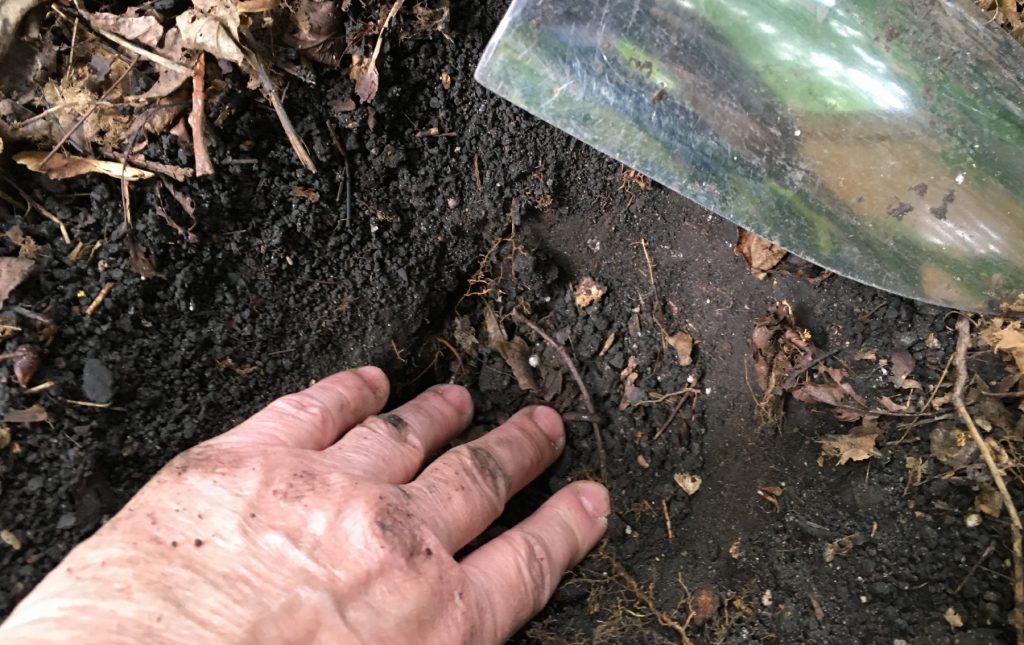
I was rushing to plant shrubs on a recent hot day when the heavens opened. Thunder boomed, lightning flashed, rain ran down my neck and dripped off my nose.
I kept at it for a while, because gardeners are waterproof and the shrubs desperately needed planting. I’d been putting it off through weeks of June days that were in the 90s, too hot to work outdoors. Where I garden near Chicago, we were already in drought conditions, and if the shrubs were going to have any chance, I needed to get them out of their pots, into the ground and well-watered. The rain would give them a good soak, I figured.
Only a couple of shrubs got planted before the lightning started to look closer and I retreated indoors to squeegee off. The thunder-and-lightning show continued outside my windows for a couple of hours, and I hoped our little local drought was broken.
Nope. The first hole I dug the next day told the truth. The soil was moist for an inch or two at the top, but farther down, it was still dry as dust. For all that boom and blast, there hadn’t been enough actual rainfall to do more than wet the soil surface.
It was a frustrating reminder of a basic fact: Just because it rained doesn’t mean it rained enough. A gardener still has to make sure there is water in the only place where it actually matters—where the roots are.
Every gardener wonders when and how much to water. New gardeners always want a simple recipe: Water X amount X times a week. But the honest answer is always, “It depends on how much water is already in your soil.” If there’s moisture where the roots can get at it, you don’t need to water. If the root zone is dry, you do.
The root zone for most garden plants, even trees, is the top foot of soil. It’s critical to have moisture deeper than the top inch or two. Too many gardeners—and too many rainstorms—provide only enough water to dampen the surface of the soil but not enough to soak deeper. Roots will only grow where water is, so if just the top inch or two of the soil is moist, your plants will have weak, shallow roots that can’t support a healthy plant.
Soil moisture won’t be the same everywhere in your garden. Open spaces out in the hot sun dry out fast, but they also are open to rain when it falls. In shady places, water doesn’t evaporate as quickly, but those places can still be dry because rain may not reach the soil at all. The leaves of trees overhead may intercept the rainfall. So can roof overhangs and buildings. Even fences affect how the wind blows and where the rain lands.
The plants that compete for moisture in any area of soil also make a big difference: Shallow-rooted maples, hydrangeas and lawn grass soak up water faster than the roots of oaks. Clay soil retains water longer than loose, sandy soil. If the soil is covered with a mayor of mulch, it won’t lose as much water to surface evaporation as bare soil. More water evaporates in hot, sunny weather than when it’s cool and cloudy.
All these variables make it impossible to give a simple watering formula. People have tried: There’s a general rule of thumb that most plants need the equivalent of about 1 inch of rain a week. I find that this rule—which comes from irrigated row-crop agriculture—is not very helpful for gardeners.

To try and follow the rule, first you have to track the rainfall in your garden using a rain gauge. If rainfall is less than 1 inch a week, you need to make up the difference by watering. But since sprinklers vary, and water pressure varies, many other factors vary, it’s extremely hard to figure out how long you need to run any particular sprinkler or soaker hose to deliver any particular quantity of water. If you water by hand, it’s even harder to tell if you’ve watered 1 inch a week. And that’s not even considering the varying conditions in different parts of your yard.
But here’s the thing: Plants don’t care. Formulas and rainfall amounts and sprinkler models mean nothing to plants. They only care whether there is moisture in the soil where their roots can get at it. And there’s a simple way to find that out: Dig down and check.
Take a trowel and make a little hole about 6 inches deep. Feel the soil. Does it feel moist about 3 inches down? Then there’s water for the roots of smaller plants. Is the soil moist 6 or 8 inches down? Good. Most likely, gravity has pulled water even further, down through the root zone of bigger plants. You don’t need to water.
But if only the top couple of inches of soil are moist, you do need to water—a lot, until you can dig a deep hole and feel moisture several inches down.
Note that just touching soil surface can be deceiving. Because moisture evaporates from the surface, it can be dry even if when there’s still moisture lower down. On the other hand, like the thunder-boomer in my town the other day, a brief or light rainfall can moisten the soil surface without soaking down far enough to do plants any good. To get the real picture, you have to dig.
Digging planting holes is an opportunity check the soil moisture. So is uprooting weeds or tree seedlings. I try to make a habit of digging a small hole whenever I have a trowel handy. If you develop that habit, you’ll come to learn which parts of your garden are likely to dry out first. You’ll learn to rely on your own senses to know when you need to water, not on farmers’ formulas. And you’ll learn not to be deceived by flashy thunderstorms.


